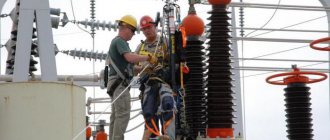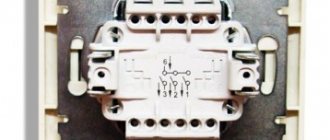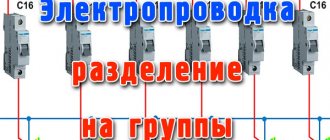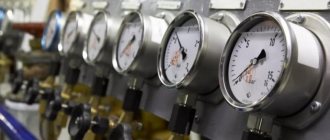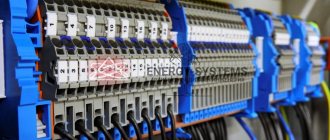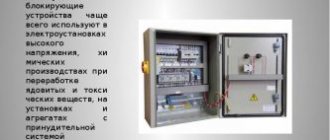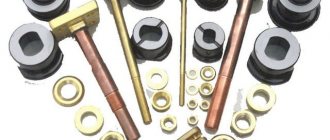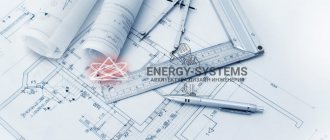Electrician for repair and maintenance of electrical equipment
2nd category
Characteristics of the work . Performing individual simple repair and maintenance work on electrical equipment under the guidance of a more highly qualified electrician. Installation and repair of distribution boxes, terminal blocks, safety panels and lighting fixtures. Cleaning and blowing with compressed air electrical equipment with partial disassembly, washing and wiping of parts. Cleaning contacts and contact surfaces. Cutting, splicing, insulating and soldering wires with voltage up to 1000 V. Laying installation wires and cables. Maintenance and repair of solar and wind power plants with a capacity of up to 50 kW. Performing simple plumbing, installation and carpentry work when repairing electrical equipment. Connecting and disconnecting electrical equipment and performing simple measurements. Working with pneumatic and electric tools. Perform rigging work using simple lifting equipment and cranes controlled from the floor. Checking and measuring with a megohmmeter the insulation resistance of distribution networks of stators and rotors of electric motors, transformer windings, cable inputs and outputs.
Must know: the structure and principle of operation of electric motors, generators, transformers, switching and control equipment, batteries and electrical appliances; main types of electrical materials, their properties and purpose; rules and methods for installation and repair of electrical equipment in the scope of the work performed; name, purpose and rules of use of the working and control and measuring tools used and basic information about production and organization of the workplace; techniques and methods for replacing, splicing and soldering low voltage wires; rules for providing first aid in case of electric shock; safety rules for servicing electrical installations in the scope of qualification group II; techniques and sequence of rigging work.
Work examples
- Lighting fittings: switches, sockets, sockets, etc. — installation with network connection.
- Cable inputs and outputs - checking the insulation resistance with a megger.
- The parts are simple - coil springs, brackets, jumpers, lugs and contacts - fabrication and installation.
- Illumination - installation.
- Cables and wires - cutting ends, crimping and soldering lugs.
- Manufacturing and installation of structures made of steel and other metals for electrical appliances.
- Contactors, relays, controllers, command devices - checking and tightening fasteners, cleaning and filing contacts, replacing and lubricating them, replacing arc extinguishing devices.
- Household electrical appliances: stoves, irons, etc. - disassembly, repair and assembly.
- Wires and cables (aerial) - installation, dismantling, repair and replacement.
- Welding transformers - disassembly, simple repairs, assembly, installation of terminal board.
- Electric lamp sockets - soldering ends.
- Switchboards and distribution boxes - replacement and installation of fuses and switches.
- Power or lighting boards with a simple circuit (up to eight groups) - manufacturing and installation.
- Electric motors and generators - partial disassembly, cleaning and blowing with compressed air, lubrication, replacement of brushes.
- Grounding electrodes - installation and driving.
3rd category
Characteristics of the work . Performing simple work at departmental power plants, transformer electrical substations with their complete disconnection from the voltage of operational switching in electrical networks, inspection of transformers, switches, disconnectors and drives to them without disassembling structural elements. Load regulation of electrical equipment installed in the serviced area. Repair, charging and installation of explosion-proof fittings. Cutting, splicing, insulating and soldering wires with voltages over 1000 V. Maintenance and repair of solar and wind power plants with a capacity of over 50 kW. Participation in the repair, inspection and maintenance of electrical equipment, including disassembly, assembly, adjustment and maintenance of electrical devices, electromagnetic, magnetoelectric and electrodynamic systems. Repair of transformers, switches, rheostats, control stations, magnetic starters, contactors and other simple equipment. Carrying out individual complex repair work under the guidance of more highly qualified electricians. Performing rigging operations using cranes and other lifting machines. Participation in laying cable routes and wiring. Charging batteries. Painting of external parts of instruments and equipment. Reconstruction of electrical equipment. Processing of insulating materials according to the drawing: textolite, getinax, fiber, etc. Checking the markings of simple wiring and circuit diagrams. Identification and elimination of failures, malfunctions and damage to electrical equipment with simple switching circuits.
Must know: basic electrical engineering; information about direct and alternating current in the scope of work performed; the principle of operation and design of serviced electric motors, generators, switchgear equipment, electrical networks and electrical appliances, oil switches, fuses, contactors, batteries, controllers, mercury and silicon rectifiers and other electrical equipment and electrical appliances; design and purpose of starting and control devices; techniques and methods for replacing, splicing and soldering high voltage wires; safe work methods, sequence of disassembly, repair and installation of electrical equipment; designations of electrical machine winding terminals; solders and fluxes; conductor and electrical insulating materials and their main characteristics and classification; design and purpose of simple and medium complexity instrumentation and devices; methods for measuring electrical quantities; techniques for finding and eliminating faults in electrical networks; rules for laying cables indoors, underground and on overhead cables; safety rules in the scope of qualification group III.
Work examples
- Ammeters and voltmeters of electromagnetic and magnetoelectric systems - testing under special conditions.
- Starting equipment: rheostats, magnetic starters, starting boxes, etc. — disassembly, repair and assembly with cleaning of burnt contacts, brushes or changing them.
- Starting equipment for magnetic stations of rolling mills, disassembly, repair and assembly.
- Brake and limit switches - repair and installation.
- Funnels, end couplings - cutting and installation on the cable.
- Selenium rectifiers - inspection and repair.
- Garlands of electric lamps - production in parallel and series connection.
- Parts of complex configuration for electrical equipment: clamps, switches, pins and resistance boxes - manufacturing.
- Cables - checking the insulation condition with a megger.
- Drilling rig control station controllers - inspection, repair, assembly and installation
- Portal cranes, container loaders - dismantling, repair, assembly of contactors, control devices, relays, circuit breakers, switches.
- Special loaders, bilge loaders, forklifts and warehouse machines dismantling, repairing and assembling controllers, contactors, switches, starting resistances, lighting and alarm devices.
- Sliding bearings for electric motors - replacement, filling.
- Electronic potentiometers for automatic temperature control of calcining furnaces and drying equipment - installation, repair and replacement.
- Devices for automatic temperature and pressure measurement; elimination of simple faults, replacement of sensors.
- Power cable wires are connected to the machine in a gas pipe.
- Intermediate autoregulator relay - check and replacement.
- Illuminated advertising - installation.
- Switch, disconnectors - regulation of contacts for simultaneous switching on and off.
- Centrifuge - inspection with cleaning of plates.
- Power or lighting boards with a complex circuit (more than eight groups) - manufacturing and installation.
- Asynchronous electric motors with a phase rotor with a power of up to 500 kW - disassembly and assembly.
- Squirrel-cage electric motors with power up to 1000 kW disassembly and assembly.
- Explosion-proof electric motors with power up to 50 kW - disassembly, repair and assembly.
- Power tools - disassembly, repair and assembly.
- Armatures, magnetic coils, brush holders of electric machines - repair and replacement.
4th category
Characteristics of the work. Disassembly and overhaul of electrical equipment for any purpose, of all types and dimensions, under the guidance of a more highly qualified electrician. Adjustment and testing of equipment and devices of electric drives after repair. Repair of amplifiers, light and sound signaling devices, controllers, control stations, magnetic stations. Maintenance of power and lighting electrical installations with complex switching circuits. Carrying out work at departmental power plants, transformer electrical substations with their complete disconnection from voltage. Performing operational switching in electrical networks with inspection of transformers, switches, disconnectors and drives to them with disassembly of structural elements. Inspection, installation and repair of fluorescent lighting circuits. Unwinding, cutting, dosing, cable laying, installation of input devices and couplings, terminations in cable lines with voltage up to 35 kV. Determination of cable damage locations, measurement of grounding resistance, potentials on the cable sheath. Identification and elimination of failures and malfunctions of electrical equipment with switching circuits of medium complexity. Soldering with soft and hard solders. Carrying out work according to drawings and diagrams. Selection of starting resistances for electric motors.
Must know: basic electronics; arrangement of various types of direct and alternating current electric motors, protective and measuring instruments, switching equipment; the most rational ways of checking, repairing, assembling, installing and servicing electric motors and electrical equipment, methods of protecting them from overvoltages; purpose of relay protection; principle of operation and circuits of overcurrent protection; selection of wire sections, fuse links and protection devices depending on the current load; design and principle of operation of semiconductor and other rectifiers; technical requirements for the execution of electrical wiring of all types; nomenclature, properties and interchangeability of electrical insulating and conductive materials used in repairs; methods for carrying out adjustment and commissioning work and handing over electrical equipment with ballasts after repair; basic electrical standards for setting up the equipment being serviced, methods for checking and measuring them; operating principle of equipment, power supplies; device, purpose and conditions of use of complex instrumentation; design of universal and special devices; safety rules in the scope of qualification group IV.
Work examples
- Electromagnetic and electromechanical interlocks - repair and regulation.
- Oil switches - repair with manufacturing and replacement of contacts, regulation for simultaneous activation of three phases and checking the plane of the contacts.
- Control devices, actuators, temperature sensors, testing, repair and adjustment.
- Control devices for lifting tables of rolling mills, inspection and repair.
- Portal cranes, container loaders - routine repairs, regulation and testing of electrical equipment.
- High voltage power lines - live test.
- Pneumatic reloaders - maintenance, routine repair of drives and ballasts, inspection and regulation.
- Sliding bearings of electric motors of all power scraping.
- Electronic potentiometers for automatic temperature control of drying and calcined ovens - repair and adjustment.
- Time relay - checking and troubleshooting electromagnetic wires.
- Selenium rectifiers - repair with replacement of washers, production of jumpers with adjustment and adjustment.
- Darkeners - repair with the manufacture of limit switches, replacement of brushes and microswitches.
- Secondary switching circuits - checking inductors.
- High-voltage distribution boards - installation with installation of fittings.
- Asynchronous electric motors with a power of over 500 kW and squirrel-cage motors with a power of over 1000 kW - disassembly, reassembly and identification of damage.
- Explosion-proof electric motors with power over 50 kW - disassembly, repair and assembly.
- Crane power supply electric columns - disassembly, repair, assembly and regulation.
- Electric precipitators - inspection, repair and installation.
5th category
Characteristics of the work . Dismantling, overhaul, assembly, installation and alignment of high-voltage electrical machines and electrical devices of various types and systems with voltage up to 15 kV. Adjustment of circuits and elimination of defects in complex devices of protective equipment and automation and telemechanics devices. Maintenance of power and lighting installations with particularly complex circuits for connecting electrical equipment and circuits of machines and units connected in a production line, as well as equipment with automatic control of the technological process. Installation and repair of cable networks with voltages over 35 kV, with installation of input devices and connecting couplings. Repair, installation, installation and commissioning of mercury rectifiers and high-frequency units with a power of over 1000 kW. Installation, repair, adjustment and maintenance of devices for automatic control of operating modes of blast furnaces, steel-smelting furnaces, rolling mills, blocking, signaling, control devices of tunnel furnaces, automated dispatch control systems, flow-transport technological lines, welding equipment with electronic control circuits, electrical equipment units and machines with electric machine control systems, with current and voltage feedback. Repair of complex electrical equipment of drying and vacuum ovens, unique overcurrent circuit breakers and automatic belts. Balancing rotors of electrical machines, identifying and eliminating vibration.
Must know: basics of telemechanics; design and electrical circuits of various electrical machines, electrical devices, electrical measuring and automatic control devices; general information about the purpose and basic requirements for maximum current protection; methods for testing electrical equipment and cable networks; diagrams of electric motors and other electrical equipment being serviced; relay design of various systems and methods for checking and adjusting it; work methods and sequence of operations for disassembling, assembling, repairing and setting up high-power electrical machines and complex electrical equipment; rules for testing protective equipment used in electrical installations; the procedure for organizing safe work in electrical installations, supervision and maintenance of operating electrical equipment; construction of geometric curves necessary for the use of devices used in repairs; the principle of operation of converters, high-frequency installations with machine and tube generators; calculation of the need for static capacitors to increase the cosine phi; methods for centering and balancing electric motors; purpose and types of high-frequency protection; rules for setting up and regulating control and measuring instruments, safety rules in the scope of qualification group IV.
Work examples
- Automatic devices for extinguishing towers of coke plants, repair and adjustment of electrical circuits.
- High-voltage oil switches - overhaul.
- High voltage cable - finding the damage, cutting out the damaged area and installing the insert,
- Contactors, magnetic controllers, limit switches - repair and regulation.
- Equipment and equipment of high voltage switchgears - repair and installation.
- Magnetoelectric load limiters - checking, adjustment and regulation.
- Control panels and magnetic stations of high-voltage electric motors of rolling mills - inspection and repair.
- Multiple drawing control panels with a complex circuit for automatically starting five drums with one button using a time relay - repair and adjustment.
- Loaders, pneumatic loaders, wagons, warehouses, bilges and other special machines - complete overhaul and regulation of electrical equipment.
- Potentiometers, selsyn sensors with gears - repair with manufacturing of parts.
- Radioisotope devices - installation and adjustment.
- Operator lighting control panels - repair and installation.
- Maximum relay, photo relay - checking, repair and regulation.
- Electric motor rotors - balancing, identifying and eliminating vibration.
- Automatic spreaders - fault detection, repair, installation, dismantling.
- Automation diagrams for roller tables, stops, valve reversal of air heaters of open-hearth furnaces - repair and adjustment.
- Electrical systems of blast furnace loading mechanisms - complete repair and adjustment.
- Elements of counting circuits of special roll length control systems, telemechanical devices on units of metallurgical plants - repair, installation and adjustment.
- High-voltage electric motors - overhaul, assembly, installation and alignment.
- Multi-motor electric drives with magnetic stations and complex automation and blocking circuits - testing and repair.
- Electric clock stations of all systems - medium and major repairs.
6th category
Characteristics of the work . Dismantling, overhaul, assembly, installation and alignment of high-voltage electrical machines and electrical devices of various types and systems with voltages above 15 to 25 kV. Maintenance of production areas or workshops with particularly complex primary and secondary switching and remote control circuits. Adjustment, repair and regulation of critical, especially complex, experimental circuits of technological equipment, complex electrical circuits of automatic lines, as well as critical and experimental electrical machines, electrical devices, electrical appliances and electrical circuits of unique and precision metalworking equipment. Maintenance, adjustment and regulation of electrical recording and electronic devices. Maintenance and adjustment of ignitron welding machines with electronics, ultrasonic, electronic, electric pulse installations, particularly complex distance protections, automatic reserve switching devices, as well as complex circuits using semiconductor installations on transistor and logical elements. Checking the accuracy classes of instrument transformers. Carrying out work on repair, installation and dismantling of cable lines in special pipelines filled with oil or gas under pressure. Complex epoxy terminations in high voltage cable networks, as well as installation of joints between copper and aluminum cables. Comprehensive testing of electric motors, electrical devices and transformers of various capacities after major repairs. Preparation of repaired electrical equipment for commissioning.
Must know: the design, electrical circuits, methods and rules for checking the accuracy of various electrical machines, electrical devices, electrical appliances of any power and voltage and automatic lines; telecontrol and automatic control circuits and methods for setting them up; device and design of complex relays and electronic system devices; rules for servicing ignitron welding machines with electronics, ultrasonic, electric pulse and electronic installations; methods of complex testing of electrical machines, electrical devices and electrical appliances; rules for drawing up electrical diagrams and other technical documentation for electrical equipment in the power supply network; electrical diagrams of primary and secondary switching of distribution devices; operating principle of protection with high-frequency blocking; circuits of voltage stabilizers, semiconductor, selenium rectifiers and telemetric control of operational lighting and operational control panels; safety rules in the scope of qualification group IV.
Secondary specialized education required.
Work examples
- Automatic dosing equipment for liquid components with electronic relays and thermostats - checking, repairing and adjusting the electrical circuit.
- DC generators - overhaul, regulation and adjustment.
- Portal cranes, container loaders - major repairs of electrical equipment.
- DC machine commutators - assembly, template making and finishing of commutator plates by hand.
- Automatic lines of metal-cutting machines - complex repairs and adjustment of electrical circuits.
- Flow lines with multi-motor, synchronized and automated drives - repair and adjustment.
- Electric seam welding machines, multi-point - repair and adjustment.
- Electric melting furnaces and hardening installations, high-frequency testing, troubleshooting and adjustment.
- Instruments and devices of the electronic system - repair and adjustment of the circuit.
- Relay of the electronic extinguishing tower of coke plants - repair, installation and commissioning.
- X-ray machines - checking, eliminating defects and setting up.
- Thyristor control systems - adjustment.
- Spreaders, lifting electromagnets - overhaul, regulation and adjustment of electrical equipment.
- Complex electrical circuits using electronics and photocells - testing, repair and adjustment.
- Electrical circuits of automatic remote control, checking, repair and adjustment.
- Electric drives with complex control circuits and distillation of operating modes.
7th category
Characteristics of the work. Dismantling, overhaul, assembly, installation and alignment of high-voltage electrical machines and electrical devices of various types and systems with voltages over 25 to 35 kV. Maintenance of power and lighting installations with particularly complex switching circuits. Repair, installation, adjustment and maintenance of high-voltage capacitor welding installations, high-frequency contact and seam welding installations with electronic control circuits. Repair and adjustment of technological welding installations. Maintenance of new and prototypes of electrical equipment and electrical devices of various types and systems with voltage up to 220 kV. High-voltage tests of high-voltage electric motors and DC machines, high-rectified voltage tests with determination of current leakage in power cables, taking pie charts of transformer switching devices, measuring capacitance and dielectric loss tangent of current and no-load losses, measuring transformation ratio, short-circuit voltage, resistance DC windings of power transformers and oil-filled reactors. Testing of arresters, instrument transformers, switching devices; maintenance of equipment used in testing and measurements, preparation of workplaces for testing and measurements. Adjustment, repair and regulation of complex, experimental circuits of technological equipment. Maintenance, adjustment and regulation of electrical recording and electronic devices. Setting up complex protections and automatic transfer switching devices. Adjustment, regulation, troubleshooting, commissioning of devices, instruments and control systems for mechanisms and components of technological equipment based on microprocessor technology with the implementation of repair and restoration work on elements of these systems, programmable controllers, monocrystalline PCs, monitoring systems for the work of technological personnel when performing transport -technological operations with radiation hazardous cargo. Diagnostics of controlled equipment systems for the transport and technological chain of radioactive materials processing. Complex adjustment and regulation of electrical equipment, units and machines, thyristor converters and motors with feedback for current, voltage and speed. Repair, testing and regulation of analog and digital DC electrical devices and thyristor converters of electric drives. Adjustment, repair, maintenance of freight elevators with electronic control, motors with frequency control. Disassembly, overhaul, assembly and maintenance of high-frequency electronic converters. Adjustment and testing of telecontrol devices, telesignaling and telemetering, mnemonic diagrams, command devices and signaling equipment. Analysis, systematization of failures in the operation of technological equipment and development of recommendations for their elimination.
Must know: basics of industrial electronics and telemechanics; design, electrical circuits, methods and rules for checking the accuracy of maintained electrical machines and electrical devices; telesignaling circuits, telemetering and methods for setting them up; diagrams of electrical appliances of any power and voltage, automatic lines; telecontrol circuits, automatic regulation and methods for setting them up; device and rules for repair, adjustment and operation of relay protection equipment, automation and secondary switching circuits; purpose and diagrams of interlocking devices; basic principles of constructing control systems based on microprocessor technology; functional and block diagrams of programmable controllers, mini- and micro-PCs, monocrystalline PCs; design of microprocessor devices; basics of programming and operating principle of an automated electric drive; methods of introducing technological and test programs; methodology for setting up systems of devices and devices of converter technology in order to obtain specified static and dynamic characteristics; methods of primary and secondary switching of complex distribution devices; particularly complex power and lighting network circuits; design, operating principle and repair rules for serviced welding installations; rules, methods and procedures for carrying out work; technical characteristics and design of the electrical equipment in use; rules for setting up and repairing complex electrical appliances and electrical devices, mercury rectifiers; operating principle of converters; rules for setting up and regulating the instrumentation used; rules for performing work in explosive, fire-hazardous and other difficult conditions; organizing a range of works to repair and identify faults in serviced equipment; rules for preparing technical documentation.
Secondary vocational education required.
Work examples
- Automatic switches - repair, adjustment.
- High-voltage vacuum circuit breakers - overhaul and adjustment of circuit breaker control devices.
- High-voltage condensation welding installations - adjustment, repair and maintenance.
- High-frequency contact welding installations - adjustment, repair and maintenance.
- A set of telemechanics means - checking, adjustment and repair.
- Laser, welding installations - adjustment, repair and regulation.
- Welding units with a microprocessor control system and frequency regulation - maintenance, repair.
- Power part of electrical equipment of frequency converters, thyristor excitation devices of synchronous generators and motors, thyristor converters of various types - major repairs, characterization of semiconductor elements.
- Water cooling systems for static frequency converters - repair.
- Schemes of induction generators - adjustment, repair and regulation.
- Filter compensating installations - repair.
- Electric drives with frequency converters - repair, maintenance.
8th category
Characteristics of the work. Dismantling, overhaul, assembly, installation and alignment of high-voltage electrical machines and electrical devices of various types and systems with voltages over 35 kV. Adjustment of circuits, elimination of defects, maintenance of particularly complex protection circuits, automation, telemechanics. Comprehensive testing of unique electrical equipment of various capacities. Identification and troubleshooting of devices of the telemechanics complex. Comprehensive testing of the operation of telemechanics device circuits. Development of circuits based on integrated and logical elements for testing devices, components and blocks of a complex of telemechanics equipment. Repair, testing, adjustment and adjustment of particularly complex distance protections, electronic semiconductor circuits for protecting and controlling drives of crane equipment, taking measurements in high-frequency channels of electrical automation equipment. Setting up equipment and troubleshooting particularly complex, experimental circuits of technological equipment using computer technology, as well as setting up programmable electronic devices. Maintenance and repair of electronic circuits of inverter welding sources. Setup and maintenance of the optical path of technological welding installations. Repair of particularly complex primary and secondary switching circuits with remote control using semiconductor circuits based on transistor and logic elements. Comprehensive technological maintenance, adjustment, repair, inspection, testing, installation and commissioning of complex control systems and monitoring the operation of equipment of technological mechanisms that provide transport and technological operations with radiation hazardous cargo, diagnostics using a package of test programs using computer technology . Drawing up tests and adjusting technological programs using computer technology. Performing particularly complex work on testing and setting up converter equipment. Testing thyristor blocks from a constant current source. Checking and tuning circuits containing logical and integrated elements. Operational maintenance and ensuring the operation of elements of monitoring and control systems operating using electronic devices based on microprocessors. Maintenance of technological protections of block design based on integrated circuits. Repair and adjustment of complex relay protection and automation devices based on microprocessor integrated circuits, complex testing devices and automatic testing installations. Complex testing of high-frequency installations using standard equipment (oscilloscope, wave meter, sound generator, etc.). Management of a complex of testing equipment. Installation, adjustment, regulation and commissioning of complex control systems, equipment based on microprocessor technology with the implementation of all types of repair and restoration work on the elements of these systems. Participation in the development of non-standard testing equipment, installation of units and testing of their functionality. Carrying out repair and adjustment work on new low-volume equipment.
Must know: design, methods of setting up reversible, regenerative converters; diagrams of devices, components and blocks of the telemechanics complex; methods for complex verification of telemechanics devices; methods for identifying and troubleshooting telemechanics devices; operating principle of semiconductor integrated and logical elements; design, scope and methods of repair of electrical machines, electrical devices and devices of various powers, voltage over 35 kV; methodology for carrying out adjustment work and testing when commissioning complex, experimental equipment; maintenance rules, circuit and design of a high-frequency generator, pulse voltage generator, logical and integrated elements, circuits for testing thyristor blocks and modules; rules for the use of control, measuring and diagnostic equipment based on electronic circuits; fundamentals of electronics and microprocessor technology; instructions for repair, adjustment, testing and operation of complex relay protection and automation equipment containing integrated circuits; methods for identifying and detecting faults in devices based on integrated circuits; methods of working with complex electronic measuring equipment; design, methods and rules for testing test installations, circuits, stands and instruments for measuring electrical parameters; ways to eliminate basic equipment malfunctions; methodology for setting up control systems of devices and devices of converter technology in order to obtain specified characteristics; methods of analysis, systematization of operation failures of serviced equipment and development of recommendations to improve its reliability; design features and operating principles of technological installations with a complex system of automatic control of technological processes using a PC and microprocessor technology; schematic diagrams of programmable controllers, micro- and mini-PCs; rules for organizing a set of works for setting up and identifying malfunctions of devices and monitoring and control systems; methods of automatic control of electric drives.
Secondary vocational education required.
Work examples
- High-frequency automation channels - troubleshooting, taking measurements.
- High-frequency generators with a power of 60 kW and above - testing.
- Inverter welding installations - adjustment, repair and maintenance.
- Optical path of laser systems - repair, adjustment and maintenance.
- Reversible, regenerative converters of crane equipment and excitation systems for synchronous electric motors - repair, testing, adjustment, adjustment.
- Schemes of experimental measuring devices and complexes - installation, adjustment, repair.
- Devices of the telemechanics complex - comprehensive testing in the mode of telemeasurement, telesignaling and telecontrol using complex measuring instruments.
- Electrical devices with software - repair and maintenance.
- Electronic circuits - repair and maintenance using computer technology.
What is the rank of an electrical technician?
2nd category The lowest level. The 2nd category implies that a person is still studying and does not have the right to work alone in this field. 3rd category Electrical installer for secondary circuits of the 3rd category carries out simple work on the installation of secondary circuits. Approximate types of work: Cutting cables with voltages up to 10 kV with temporary sealing of ends. Sealing of passages for all types of wiring through walls and ceilings. Rolling out wires and cables with the installation of drums. Installation of grounding networks and grounding devices. Dismantling of simple apparatus and devices. Punching holes with power tools. Installation of branch boxes for cables and wires. Assembly apartment and interfloor electrical panels. Laying steel and plastic pipes in grooves, along the floor, walls, trusses and columns. 4th category Electrician for power networks and electrical equipment 4th category performing work of medium complexity on installation
Training of electricians
However, one should not assume that the knowledge and skills acquired during study and in practice will be sufficient for work. Even the most qualified electrical installers systematically improve their knowledge in advanced training courses by exchanging experience, reading technical literature, attending lectures on special issues, getting acquainted with the projects to be worked on, new electrical equipment and products, etc.
n. It cannot be otherwise, since electrical engineering and electrical installation production are constantly developing and improving.
Improvement of the profession is not limited. As professional skills increase in production, the rank also increases. At the same time, you can continue your education at a technical school or higher education institution.
The prospects opening up for electricians, including the procedure for increasing the rank, are written in detail in § 10. The ranks are assigned
Who Assigns the Categories for the Electrician Profession
A first-class electrician can perform the simplest work and must own a special tool. Electricians of the second and third category have access to installations up to 1000 V.
These specialists work in small enterprises or as part of teams in factories and large factories. Qualifications and categories of electricians More in-depth knowledge of all the circuits and nuances of your site. Knowledge not only of safety precautions, but also an understanding of the reasons for all its provisions.
Ability to train personnel and provide first aid in case of electric shock.
Work experience ranges from 3 to 42 months minimum. The profession of an electrician requires a high level of concentration and responsibility not only for one’s own life, but also for the health of subordinates. What specialties to study? To get the opportunity to work as an electrician, you should choose a specialty
"Relay protection and automation of electrical power systems"
.
History of the profession
The profession of electrician appeared relatively recently. At the end of the nineteenth century, the first power plants began to appear and networks were laid. It was at this moment that the need arose for personnel who could service these stations. With the development of electrical networks and the construction of more and more new stations, there is a demand for specialists in the electrical power industry.
Currently, electricians are required in almost every enterprise. Organizations that service apartment buildings have an electrician on their staff who is responsible for intra-building networks. Due to the prevalence of the profession and the difficult work, quite high demands are placed on specialists.
